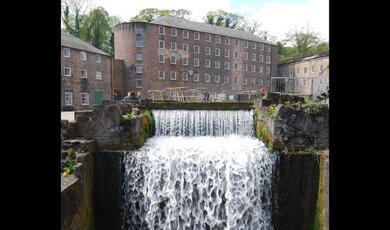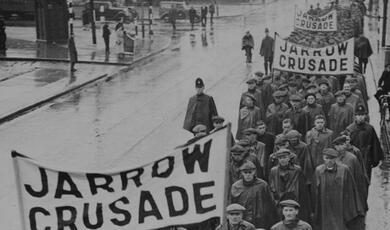The Medieval Agricultural Revolution: New evidence
Share
- Details
- Text
- Audio
- Downloads
- Extra Reading
During the medieval ‘agricultural revolution’, new forms of cereal farming fuelled the exceptionally rapid growth of towns, markets and populations across much of Europe. The use of the mouldboard plough and systematic crop rotation were key developments and led to open-field farming, one of the transformative changes of the Middle Ages.
Using new evidence from plant and animal remains from archaeological excavations in England, this lecture links these to wider developments in medieval society, notably growing social and wealth inequalities.
Download Text
The Medieval Agricultural Revolution. New Evidence
Professor Helena Hamerow
23rd March 2023
The Medieval Agricultural Revolution And The ‘Cerealisation’ Of England.
A growing emphasis on arable farming during the period from c AD 800-1300 saw the ‘cerealisation’ of the English countryside. The large cereal surpluses this generated fuelled exceptionally steep population growth as well as the expansion of towns and markets. The production of large, regular surpluses was largely achieved by the introduction of a form of low-input farming commonly known as open field farming; the best-known type of open field farming is three-field, or common-field farming, in which most of a community’s arable lay in two or more large, unenclosed fields and the holdings of individual farmers took the form of intermingled strips within those fields. The spread of this type of farming has been described by some historians as marking an agricultural revolution. Portrayals of this period as one of rapid, technologically-driven change have rightly been challenged, yet the spread of open field farming and the adoption of new ploughing technology (i.e. the mouldboard plough) remain amongst the most transformative changes of the Middle Ages.
The increasing emphasis on cereal farming in this period was also linked to increasing wealth disparities, as it had been since later prehistory (cf. Scott 2017). The advent of new, ever more extensive forms of cereal farming enabled landowners to amass and mobilize wealth in the form of marketable surpluses of grain, by exploiting the labour of others. In England, from the 10th century onwards, kings granted small land units to local lords. By 1066, there were thousands of such landowners, prospering from the cereal surpluses produced by peasant labour.
For over a century, debate has revolved around when, why and how ‘the revolution’ happened and just how revolutionary it was; was it essentially a pre-Conquest development, or was it linked to the ‘Norman yoke’? Did these farming regimes evolve slowly, over several centuries, or are they associated with a ‘village moment’? This debate about the grand narrative of the Medieval Agricultural Revolution has reached to something of an impasse, with no consensus being reached. Why can’t we agree? The central problem is a lack direct, closely dated evidence for medieval fields and for the conditions in which crops were grown. We need new data.
The ‘Feedsax’ Project And How It Has Generated New, Direct Evidence For The Conditions In Which Medieval Crops Were Grown.
The Primary Source Materials
The project analysed plant and animal remains excavated from medieval sites from across England. In total, over 4000 archaeobotanical samples from c 300 sites and 700 animal bone assemblages from around 400 sites were examined. Largely for reasons of differential preservation, the Central and Eastern zones of England produced the most abundant data.
The Methods Used
Functional Weed Ecology
The kinds of weeds that grow alongside cereal crops vary according to soil condition, the season when crops are sown, etc. The study of preserved arable weed seeds, accidentally harvested along with the crops, can therefore reveal the soil conditions in which medieval crops were grown.
Zooarchaeology
Cattle that pulled a heavy plough were more likely to develop certain deformities in their feet which can be recognized and recorded by specialists, so the study of cattle bones has allowed us to trace the spread of the mouldboard plough and of dedicated plough teams.
Archaeobotany
The study of preserved plant remains, in this case charred cereal grains, allows us to estimate the proportions of different crops grown and how this varied regionally.
Crop stable isotope analysis of medieval cereal grains (preserved by accidental charring) can be used to establish whether different crops were grown in rotation within the same field(s), or separately, in different fields.
Key Results Relating To Three Major Components Of The ‘Revolution’ (The ‘Mouldboard Plough Package’).
The ‘Extensification’ Of Cereal Farming
The scale and intensity of farming changed over the course of the Middle Ages with implications for soil. On way of increasing overall output is to cultivate more land while investing less ‘input’ (manure and human labour) per land unit. Open field farming, for example, is a land-extensive, rather than labour-intensive system, as fertility was maintained not by intensive manuring, but by regular short fallow periods during which sheep grazed on the fallow, topping up soil fertility with their droppings. A study of the arable weeds associated with medieval cereal grains has revealed increasingly extensive, low-fertility soil conditions, both for individual sites and for the Central Zone of England as a whole.
Systematic Crop Rotation
When was it introduced and how did it spread? Collective decisions about crop rotation and fallow grazing were a fundamental feature of open field systems. Different sowing times – e.g. wheat in autumn, barley in spring -- would be reflected in the weeds associated with different crops. In addition, nitrogen isotope ratios in preserved grains indicate whether different cereals – bread wheat, barley, oats, rye -- grew in the same soil conditions and so potentially in rotation, or separately, in different fields. The results reveal that, although introduced in the 8th/9th centuries, systematic rotation did not become widespread until the mid-10th and 11th centuries.
The Mouldboard Plough
When did this key innovation, which increased soil disturbance and improved tillage, enabling farmers to cultivate heavier, more productive soils, begin to make an impact? The evidence provided by arable weeds and cattle bones is helpful here. Modern baseline data from botanical surveys carried out at Laxton, Notts. (‘England’s last open field village’), Highgrove, Home Farm (Glos). and an experimental farm at the UNESCO World Heritage Site of Lorsch Abbey in Germany, enabled us to interpret the medieval data more accurately. Again, after a gradual increase in levels of soil disturbance and what we have called a ’draught cattle’ signature, a tipping point seems to have been reached in the later tenth and eleventh centuries, after which all of the case-study sites studied display evidence for mouldboard plough use.
How Should We Interpret The Archaeological Evidence For Rural Settlements In Light Of These Results?
Three periods of change in rural settlement can now be linked to developments in farming:
The ‘Long 8th Century’
This saw the emergence of the first post-Roman droveways, livestock enclosures, and hay meadows, implying that livestock were being managed in new ways and that farmers were pooling their labour in order to construct and maintain sometimes extensive complexes of ditched enclosures. These were associated with ‘semi nucleations’ of loosely articulated farmsteads, especially in central and eastern England. This period also saw investment in the first centralized crop processing and storage facilities since the Roman period, such as grain drying and malting ovens, watermills, and barns, features associated with monastic and other high-status sites.
The 10th Century
This is when we see the first archaeologically distinctive ‘aristocratic’ settlements or ‘proto-manors’. Some of these were the residences of local lords who had been granted land and who extracted and mobilized the surpluses it generated to fund elite lifestyles. Others could have been built by ‘upwardly mobile’ ceorls, prosperous independent peasants who had acquired enough land and wealth to attain thegnly status, perhaps thanks to innovative farming regimes. Examples of this kind of complex include excavated settlements at Goltho (Lincs.), Faccombe Netherton (Hants) and Raunds (Northants).
The 11th-13th Centuries
The third and final change in rural settlement took place in the post-Conquest period. This is when nucleated villages began to appear in parts of the country, with planned arrangements of contiguous, clearly defined house plots. John Blair (2018) has described the impact of these villages on the landscape as ‘weightier and more permanent than any since the Roman occupation’; we can still walk through such villages today. Nevertheless, we have found nothing to suggest major innovations in farming in this period. The key changes had already happened. The density of charred grains per sample does, however, increase sharply, implying an increased scale of production, while analysis of sheep and cattle bones indicates increased numbers of livestock overall. Written sources and scatters of pottery sherds associated with manuring also indicate that, by the 12th & 13th c, landowners were going to considerable lengths to boost soil fertility and productivity by manuring, planting ‘green manures’, hand-weeding, etc. The weed ecology of those fields demonstrates, however, that their efforts were insufficient to halt an overall trend – albeit a subtle one – towards diminishing levels of fertility. Farmers were fighting a losing battle to maintain soil fertility.
Conclusions
A ‘Long’ Agricultural Revolution
What emerges from the work undertaken by the FeedSax team is a ‘long’ agricultural revolution that began in the 8th century with the appearance of distinctively low-input cereal farming and was largely complete, at least in terms of technical innovations, by the time of the Norman Conquest, although the scale of cereal farming continued to expand. No single period saw ‘revolutionary’ change, although the ‘long 8th century’ did see significant innovations in crop and animal husbandry practices. If these innovations had been initiated by local lords – the inhabitants of ‘proto manors’ -- we would not expect to find evidence for them prior to the 10th c. Yet arable weed flora indicates that the shift to larger-scale, low-input cultivation does pre-date the 10th c, suggesting that it originated on peasant farms as well as monasteries and royal centres, driven perhaps by population growth and the development of the first formal, coin-using markets since the Roman period. The increasingly widespread adoption of systematic crop rotation and the mouldboard plough from the 10th century onwards, together with a regional fine-tuning of cropping regimes, however, is consistent with a degree of ‘top down’ pressure to increase outputs. Our results, in short, indicate that the different elements of the mouldboard plough package did not come together in a single revolutionary moment, or follow a single, shared trajectory but rather that the ‘cerealisation’ of England was a centuries-long process, punctuated by periods of innovation and more rapid change.
The ‘Endgame’ Of Extensification
Just over 700 years ago, Europe emerged from a subsistence crisis of such magnitude, that it is still referred to as the Great Famine. Countless people perished, and it marked the end of the period of population growth and relative prosperity we have just considered. The triggers of the Great Famine are clear: it began in 1315 with a series of adverse weather events and resulting crop failures; Rinderpest – a disease affecting cattle and sheep – led to a catastrophic decline in livestock numbers. But was that all? After all, there had been adverse weather events and indeed famines before. What made this one so much worse? Could centuries of highly extensive, low-input farming regimes and the associated deterioration in soil fertility, the evidence for which we have seen, have been an underlying causal factor? After feeding a rapidly growing population for some 500 years, was this the ‘end game’ of extensification, a process that had started in the Bronze Age?
Ongoing experimental work with colleagues in Germany may provide some answers.
© Professor Helena Hamerow 2023
References and Further Reading
Banham, D. and R. Faith. Anglo-Saxon Farms and Farming. 2014.
Blair, W.J. Building Anglo-Saxon England. 2018.
Hamerow, H. Rural settlements and Society in Anglo-Saxon England. 2012.
Hamerow, H. and M. McKerracher (eds.). New Perspectives on the Medieval ‘Agricultural Revolution’. Crop, Stock and Furrow. 2022.
Scott, J. Against the Grain. A Deep History of the Earliest States. 2017.
Williamson, T. Shaping Medieval Landscapes. 2013.
References and Further Reading
Banham, D. and R. Faith. Anglo-Saxon Farms and Farming. 2014.
Blair, W.J. Building Anglo-Saxon England. 2018.
Hamerow, H. Rural settlements and Society in Anglo-Saxon England. 2012.
Hamerow, H. and M. McKerracher (eds.). New Perspectives on the Medieval ‘Agricultural Revolution’. Crop, Stock and Furrow. 2022.
Scott, J. Against the Grain. A Deep History of the Earliest States. 2017.
Williamson, T. Shaping Medieval Landscapes. 2013.
Part of:
This event was on Thu, 23 Mar 2023
Support Gresham
Gresham College has offered an outstanding education to the public free of charge for over 400 years. Today, Gresham College plays an important role in fostering a love of learning and a greater understanding of ourselves and the world around us. Your donation will help to widen our reach and to broaden our audience, allowing more people to benefit from a high-quality education from some of the brightest minds.


 Login
Login







